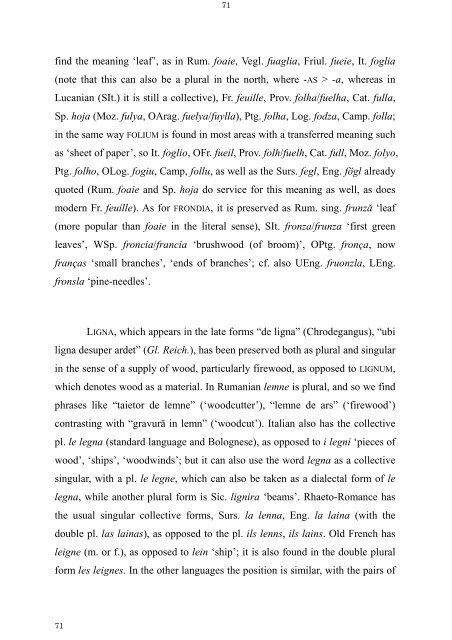The Latin Neuter Plurals in Romance - Page ON
The Latin Neuter Plurals in Romance - Page ON
The Latin Neuter Plurals in Romance - Page ON
Create successful ePaper yourself
Turn your PDF publications into a flip-book with our unique Google optimized e-Paper software.
71<br />
71<br />
f<strong>in</strong>d the mean<strong>in</strong>g ‘leaf’, as <strong>in</strong> Rum. foaie, Vegl. fuaglia, Friul. fueie, It. foglia<br />
(note that this can also be a plural <strong>in</strong> the north, where -AS > -a, whereas <strong>in</strong><br />
Lucanian (SIt.) it is still a collective), Fr. feuille, Prov. folha/fuelha, Cat. fulla,<br />
Sp. hoja (Moz. fulya, OArag. fuelya/fuylla), Ptg. folha, Log. fodza, Camp. folla;<br />
<strong>in</strong> the same way FOLIUM is found <strong>in</strong> most areas with a transferred mean<strong>in</strong>g such<br />
as ‘sheet of paper’, so It. foglio, OFr. fueil, Prov. folh/fuelh, Cat. full, Moz. folyo,<br />
Ptg. folho, OLog. fogiu, Camp, follu, as well as the Surs. fegl, Eng. fögl already<br />
quoted (Rum. foaie and Sp. hoja do service for this mean<strong>in</strong>g as well, as does<br />
modern Fr. feuille). As for FR<strong>ON</strong>DIA, it is preserved as Rum. s<strong>in</strong>g. frunză ‘leaf<br />
(more popular than foaie <strong>in</strong> the literal sense), SIt. fronza/frunza ‘first green<br />
leaves’, WSp. froncia/francia ‘brushwood (of broom)’, OPtg. fronça, now<br />
franças ‘small branches’, ‘ends of branches’; cf. also UEng. fruonzla, LEng.<br />
fronsla ‘p<strong>in</strong>e-needles’.<br />
LIGNA, which appears <strong>in</strong> the late forms “de ligna” (Chrodegangus), “ubi<br />
ligna desuper ardet” (Gl. Reich.), has been preserved both as plural and s<strong>in</strong>gular<br />
<strong>in</strong> the sense of a supply of wood, particularly firewood, as opposed to LIGNUM,<br />
which denotes wood as a material. In Rumanian lemne is plural, and so we f<strong>in</strong>d<br />
phrases like “taietor de lemne” (‘woodcutter’), “lemne de ars” (‘firewood’)<br />
contrast<strong>in</strong>g with “gravură <strong>in</strong> lemn” (‘woodcut’). Italian also has the collective<br />
pl. le legna (standard language and Bolognese), as opposed to i legni ‘pieces of<br />
wood’, ‘ships’, ‘woodw<strong>in</strong>ds’; but it can also use the word legna as a collective<br />
s<strong>in</strong>gular, with a pl. le legne, which can also be taken as a dialectal form of le<br />
legna, while another plural form is Sic. lignira ‘beams’. Rhaeto-<strong>Romance</strong> has<br />
the usual s<strong>in</strong>gular collective forms, Surs. la lenna, Eng. la la<strong>in</strong>a (with the<br />
double pl. las la<strong>in</strong>as), as opposed to the pl. ils lenns, ils la<strong>in</strong>s. Old French has<br />
leigne (m. or f.), as opposed to le<strong>in</strong> ‘ship’; it is also found <strong>in</strong> the double plural<br />
form les leignes. In the other languages the position is similar, with the pairs of









